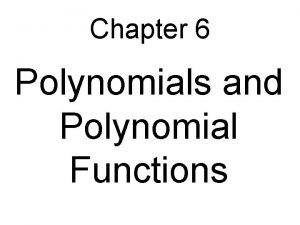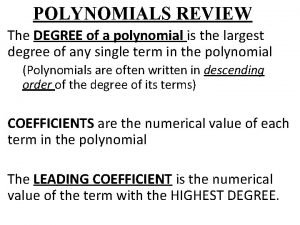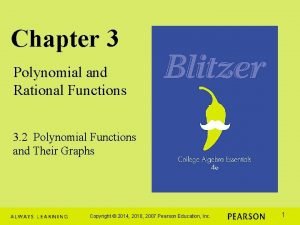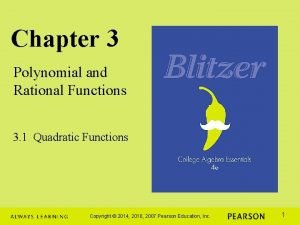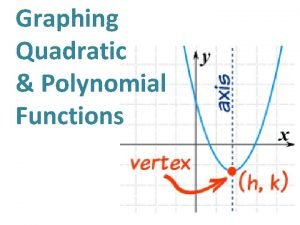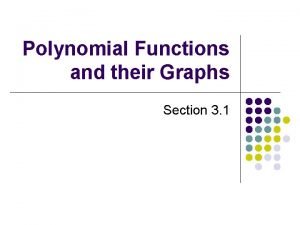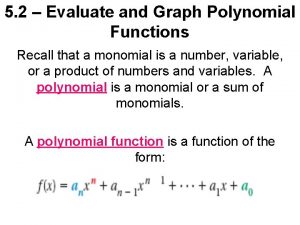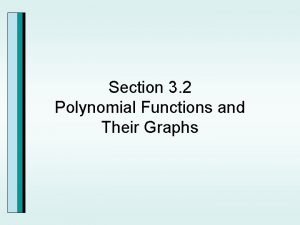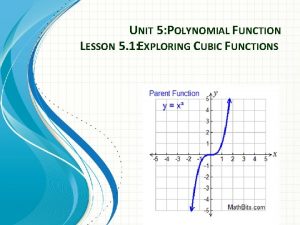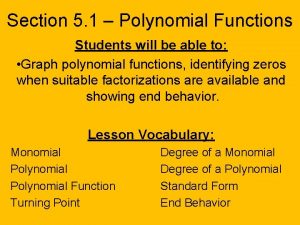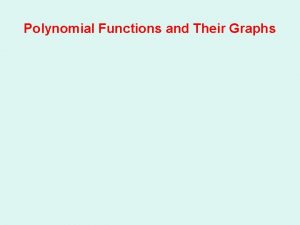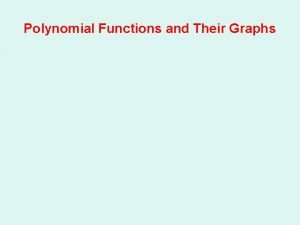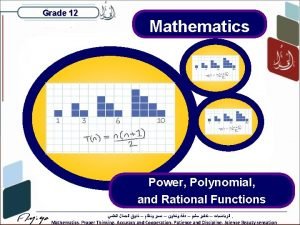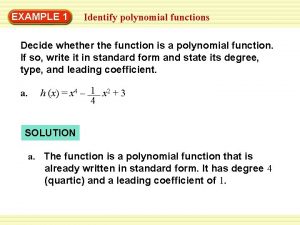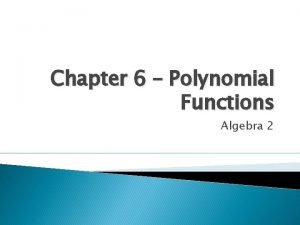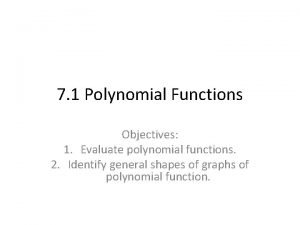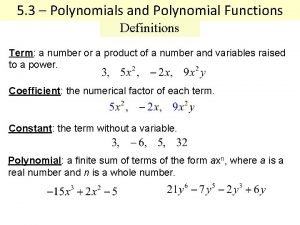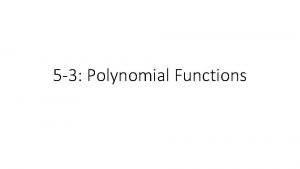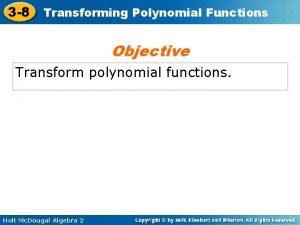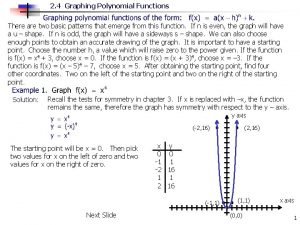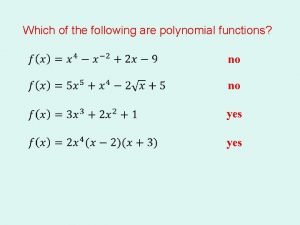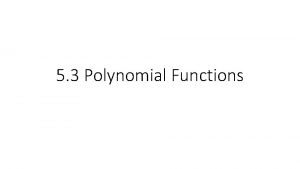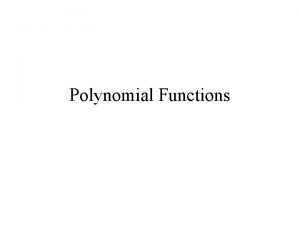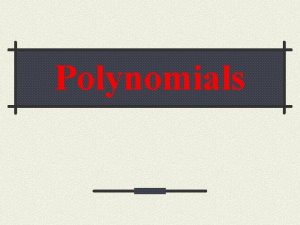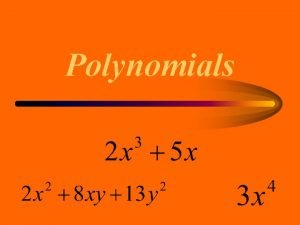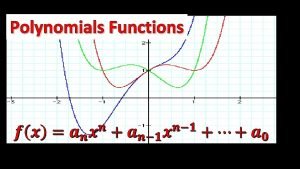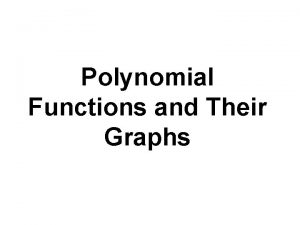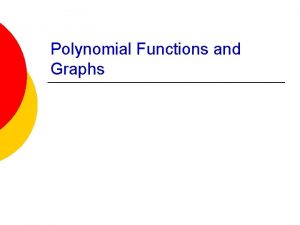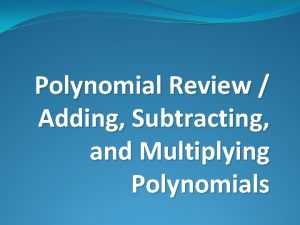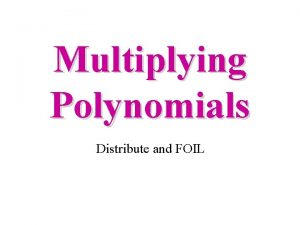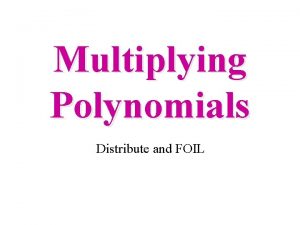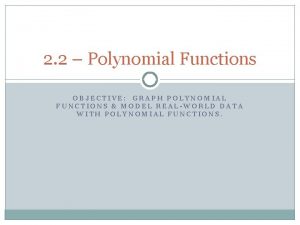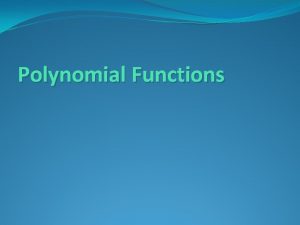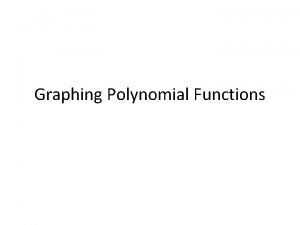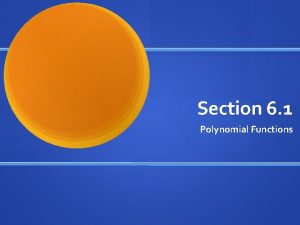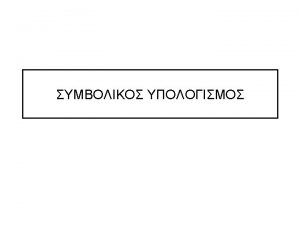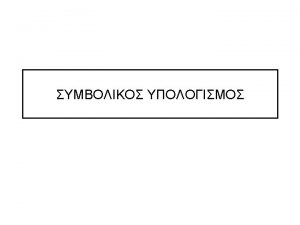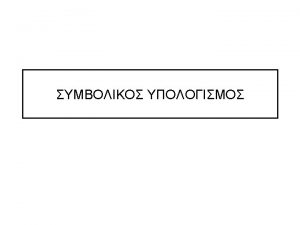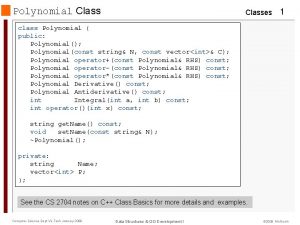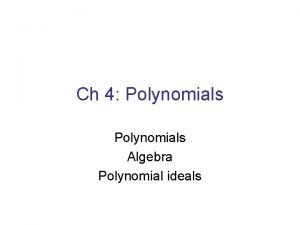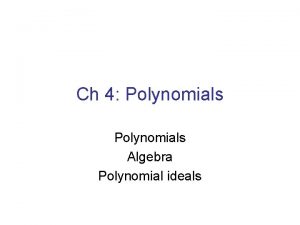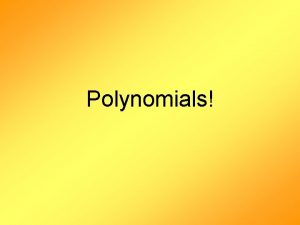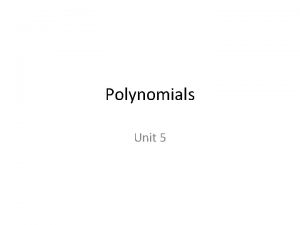Chapter 6 Polynomials and Polynomial Functions 6 1





























- Slides: 29

Chapter 6 Polynomials and Polynomial Functions

6. 1 Using Properties of Exponents

Properties of Exponents Let a and b be real numbers and let m and n be integers. PRODUCT OF POWERS PROPERTY am • an = am+n POWER OF A POWER PROPERTY (am)n = amn POWER OF A PRODUCT PROPERTY (ab)m = ambm NEGATIVE EXPONENT PROPERTY ZERO EXPONENT PROPERTY QUOTIENT OF POWERS PROPERTY POWER OF A QUOTIENT PROPERTY a 0 = 1, a ≠ 0

A number is expressed in Scientific Notation if it is in the form c X 10 n where 1 ≤ c < 10 and n is an integer. Decimal to scientific Notation: 5, 284, 000 = 5. 284 X 106 0. 0000075 = 7. 5 X 10 -6 Scientific Notation to decimal: 3. 45670123 X 108 = 345, 670, 123 6. 546 X 10 -5 = 0. 00006546

Classwork: Pg 326 – 328 (1 -15, 48, 52, 53) Homework: Pg 326 – 328 (16 -46 every 3 rd, 47, 49 -51, 54 -56)

6. 2 Evaluating and Graphing Polynomial Functions

A Polynomial Function : Leading Coefficient: Constant Term: a 0 Degree: n Standard Form: terms are written in descending order of exponents from left to right

A Polynomial Function in Standard Form: Leading Coefficient: Constant Term: 5 Degree: 3 Standard Form: terms are written in descending order of exponents from left to right

Polynomial Classifications Degree Type Standard Form 0 Constant f(x)=a 0 1 Linear 2 Quadratic 3 Cubic f(x)= a 3 x 3 + a 2 x 2 + a 1 x + a 0 4 Quartic f(x)= a 4 x 4 + a 3 x 3 + a 2 x 2 + a 1 x +a 0 f(x)= a 1 x+a 0 f(x)= a 2 x 2 + a 1 x + a 0

Synthetic Substitution Use synthetic Substitution to evaluate f(x)=2 x 4 - 8 x 2 + 5 x – 7 when x = 3. Write the value of x and the coefficients of ƒ(x) as shown. Polynomial in standard form 2 x 4 + 0 x 3 - 8 x 2 + 5 x – 7 2 0 -8 add 6 18 5 -7 30 105 35 98 3 3 Coefficients f(3) = 98 X x-value 2 6 10 The value of f(x) is the last number written in the bottom right hand corner

END BEHAVIOR FOR POLYNOMIAL FUNCTIONS For an>0 and n is even, both ends point up For an>0 and n is odd, left end points down and right end points up For an<0 and n is even, both ends point down For an<0 and n is odd, left end points up and right end points down See chart on pg 331

Graphing Polynomial Functions To graph the function, make a table of values and plot the corresponding points. Connect the points with a smooth curve and check the end behavior. ƒ(x) = x 3 + x 2 - 4 x – 1 x f(x) -3 -7 -2 3 -1 3 0 -1 1 -3 2 3 3 23

Classwork: Pg 333 – 336 (1 -13, 65, 68) Homework: Pg 333 – 336 (15, 16, 20, 21, 22, 25, 27, 28, 36, 37, 41, 45, 47, 4952, 53, 56, 59, 62, 66, 70, 81)

6. 3 Adding, Subtracting, and Multiplying Polynomials

To add or subtract polynomials, add or subtract the coefficients of like terms. You can use a vertical or horizontal format. 3 x 3+ 2 x 2 – x - 7 (9 x 3 - 2 x + 1) + (5 x 2 + 12 x - 4) = 9 x 3 + 5 x 2 - 2 x + 1 – 4 + x 3 - 10 x 2 - x + 8 = 9 x 3 + 5 x 2 + 10 x - 3 4 x 3 - 8 x 2 - x + 1 8 x 3 - 3 x 2 - 2 x + 9 -(2 x 3 + 6 x 2 -x + 1) -2 x 3 - 6 x 2 + x - 1 Add the opposite. 6 x 3 – 9 x 2 – x + 8 (2 x 2 + 3 x) -(3 x 2 + x - 4) = 2 x 2 + 3 x - 3 x 2 - x + 4 = - x 2 + 2 x + 4 Add the opposite.

Multiplying Polynomials To Multiply polynomials, use the distributive property regardless if you use the vertical or horizontal method. Horizontally Vertically (x - 3)(3 x 2 - 2 x - 4)=x(3 x 2)+x(-2 x)+x(-4)-3(3 x 2)-3(-2 x)-3(-4) =3 x 3 – 2 x 2 - 4 x – 9 x 2 + 6 x + 12 - x 2 + 2 x + 4 X =3 x 3 – 11 x 2 + 2 x +12 x-3 3 x 2 - 6 x - 12 Multiply -x 2 + 2 x + 4 by -3. -x 3 + 2 x 2 +4 x Multiply -x 2 + 2 x + 4 by x. -x + 5 x 2 – 2 x - 12 Combine like terms.

Special Product Patterns SUM AND DIFFERENCE (a + b)(a - b) = a 2 - b 2 Example (x + 3)(x - 3) = x 2 - 9 SQUARE OF A BINOMIAL (a + b)2 = a 2 + 2 ab + b 2 (y + 4)2 = y 2 + 8 y + 16 (a - b)2 = a 2 - 2 ab + b 2 (3 t 2 - 2)2 = 9 t 4 - 12 t 2 + 4 CUBE OF A BINOMIAL (a + b)3 = a 3 + 3 a 2 b + 3 ab 2 + b 3 (x + 1)3 = x 3 + 3 x 2 + 3 x + 1 (a - b)3 = a 3 - 3 a 2 b + 3 ab 2 - b 3 (p - 2)3 = p 3 - 6 p 2 + 12 p - 8

Classwork: Pg 341 – 343 (1 -12) Homework: Pg 341 – 343 (13 – 60 every 3 rd, 62, 63)

6. 4 Factoring and Solving Polynomial Equations

In Chapter 5 you learned how to factor the following types of quadratic expressions. TYPE EXAMPLE General trinomial 2 x 2 - 5 x - 12 = (2 x + 3)(x - 4) Perfect square trinomial x 2 + 10 x + 25 = (x + 5)2 Difference of two squares 4 x 2 - 9 = (2 x + 3)(2 x - 3) Common monomial factor 6 x 2 + 15 x = 3 x(2 x + 5) In this lesson you will learn how to factor other types of polynomials.

SPECIAL FACTORING PATTERNS SUM OF TWO CUBES Example a 3 + b 3 = (a + b)(a 2 - ab + b 2) x 3 + 8 = (x + 2)(x 2 - 2 x + 4) DIFFERENCE OF TWO CUBES a 3 - b 3 = (a - b)(a 2 + ab + b 2) x 3 + 27 = x 3 + 33 8 x 3 - 1 = (2 x - 1)(4 x 2 + 2 x + 1) Sum of two cubes = (x + 3)(x 2 - 3 x + 9) 16 u 5 - 250 u 2 = 2 u 2(8 u 3 - 125) = 2 u 2[(2 u)3 – 53] = 2 u 2(2 u - 5)(4 u 2 + 10 u + 25) Factor common monomial. Difference of two cubes

Factor By Grouping The pattern for this is as follows. ra + rb + sa + sb = r(a + b) + s(a + b) = (r + s)(a + b) x 3 - 2 x 2 - 9 x + 18 = x 2(x - 2) - 9(x - 2) Factor by grouping. = (x 2 - 9)(x - 2) = (x + 3)(x - 2) Difference of squares

In Chapter 5 you learned how to use the zero product property to solve factorable quadratic equations. You can extend this technique to solve some higher-degree polynomial equations. Solve 2 x 5 + 24 x = 14 x 3 Write original equation. 2 x 5 - 14 x 3 + 24 x = 0 Rewrite in standard form. 2 x(x 4 - 7 x 2 + 12) = 0 Factor common monomial. 2 x(x 2 - 3)(x 2 - 4) = 0 Factor trinomial. 2 x(x 2 - 3)(x + 2)(x - 2) = 0 Factor difference of squares. x = 0, x = Zero product property , x=- The solutions are 0, , x = -2, or x = 2 , , -2, and 2. Check these in the original equation.

Classwork: Pg 348 – 350 (1 -3, 5 -16, 88) Homework: Pg 348 – 350 (18, 21, 24, 2732, 33, 37, 41, 45, 49, 50, 51, 68, 71, 77, 80, 89)

6. 5 The Remainder and Factor Theorems If a polynomial ƒ(x) is divided by x -k, then the remainder is r = ƒ(k). REMAINDER THEOREM A polynomial ƒ(x) has a factor x - k if and only if ƒ(k) = 0. FACTOR THEOREM

Polynomial Long Division Divide 2 x 4 + 3 x 3 + 5 x - 1 by x 2 - 2 x + 2. Subtract 2 x 2(x 2 - 2 x+2) Subtract 7 x(x 2 - 2 x+2) Subtract 10(x 2 - 2 x+2) Remainder Answer

Synthetic Division Divide x 3 + 2 x 2 - 6 x - 9 by x - 2 Solve for x: x-2=0 2 1 X=2 1 2 -6 -9 2 8 4 4 2 -5 When writing solution, reduce the degree of the polynomial by 1. Add the remainder divided by the divisor at the end of the answer Answer

If the remainder is 0 then the divisor is a solution or a zero or a factor. You can use this fact to help factor completely.

Classwork: Pg 356 -358 (4 -13, 39, 47) Homework: P 356 – 358 (15 -54 every 3 rd)
 Factoring patterns
Factoring patterns Polynomial review
Polynomial review Chapter 4 polynomial and rational functions
Chapter 4 polynomial and rational functions Chapter 3 polynomial and rational functions
Chapter 3 polynomial and rational functions Chapter 3 polynomial and rational functions
Chapter 3 polynomial and rational functions Numpy.polynomial.polynomial
Numpy.polynomial.polynomial How to divide a polynomial by another polynomial
How to divide a polynomial by another polynomial Quadratic and polynomial functions
Quadratic and polynomial functions Different types of polynomial
Different types of polynomial Evaluate and graph polynomial functions
Evaluate and graph polynomial functions Polynomial functions and their graphs
Polynomial functions and their graphs Analyzing graphs of polynomial functions calculator
Analyzing graphs of polynomial functions calculator Unit 5 polynomial functions homework 1
Unit 5 polynomial functions homework 1 Unit 5 polynomial functions
Unit 5 polynomial functions 5-1 polynomial functions
5-1 polynomial functions Identify function
Identify function Leading coefficient of a polynomial
Leading coefficient of a polynomial Investigating graphs of functions for their properties
Investigating graphs of functions for their properties Investigating graphs of functions for their properties
Investigating graphs of functions for their properties End behavior of polynomials
End behavior of polynomials Rational equations
Rational equations Direct substitution polynomial
Direct substitution polynomial Algebra 2 polynomial functions
Algebra 2 polynomial functions Evaluation of polynomial function
Evaluation of polynomial function Transformation of polynomial functions
Transformation of polynomial functions 5-3 skills practice polynomial functions
5-3 skills practice polynomial functions Even degree polynomial
Even degree polynomial Transformations polynomial functions
Transformations polynomial functions (-2 4) graph
(-2 4) graph Sign of functions leading coefficient
Sign of functions leading coefficient
